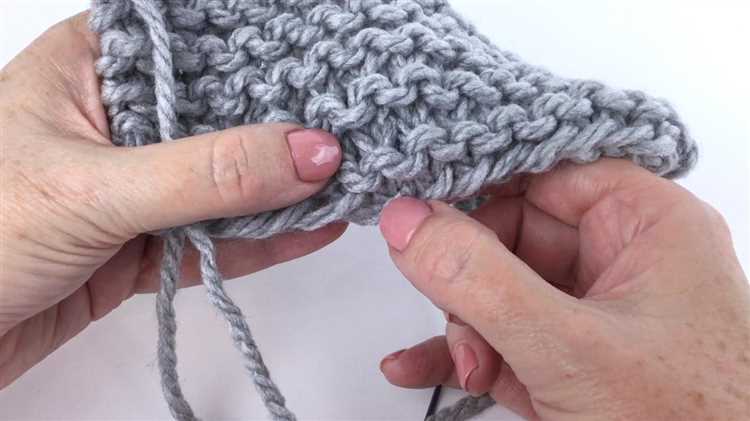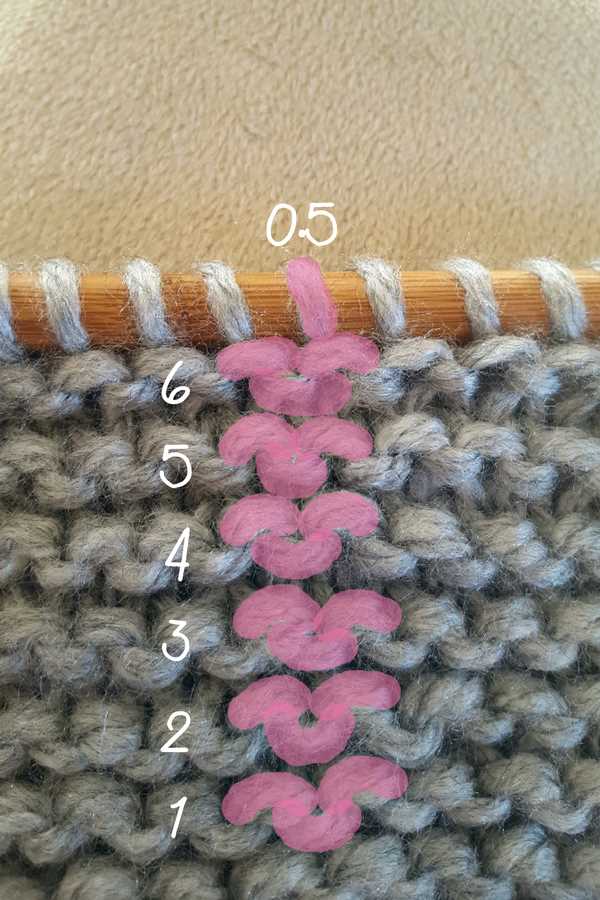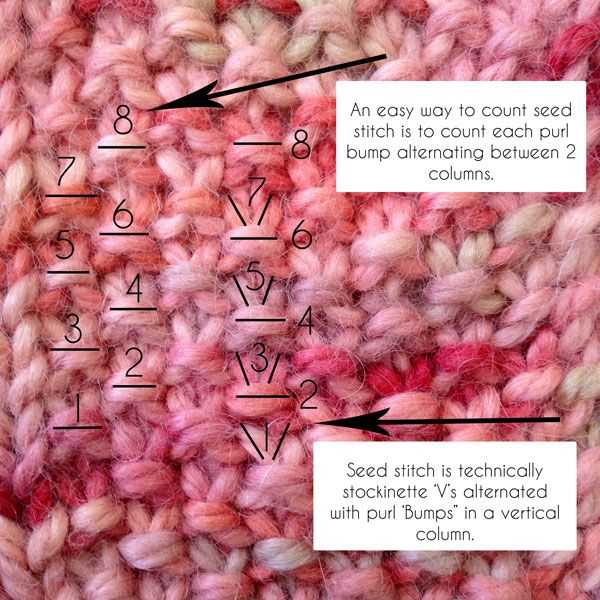Counting rows in knitting is an essential skill every beginner knitter should learn. It helps to ensure that your project turns out the correct size and shape, and it also allows you to keep track of your progress. Whether you’re knitting a simple scarf or tackling a more complex pattern, being able to count rows accurately will be extremely beneficial.
One of the most common methods for counting rows in knitting is by using a row counter. A row counter is a small device that attaches to your knitting needles and helps you keep track of the number of rows you have completed. It is a handy tool that eliminates the need to manually count each row and reduces the risk of losing track.
If you prefer a more traditional approach, you can also count rows by hand. To do this, start by identifying a vertical line of stitches on your work. Use your finger or a knitting needle to trace this line up or down, counting each ridge or “V” shape as you go. Make sure to count every row, including the edge stitches, to get an accurate count.
When counting rows, it’s crucial to pay attention to the pattern instructions. Some patterns may have specific instructions on how to count rows or include repeat sections that require additional counting. It’s always a good idea to read through the pattern carefully before you start to ensure you understand how to count rows correctly.
By mastering the skill of counting rows, you’ll have more control over your knitting projects and be able to achieve the desired results. So, whether you choose to use a row counter or count by hand, take the time to practice and refine this essential skill. With practice, you’ll become more confident in your knitting abilities and be able to tackle more complex patterns with ease.
Understanding Row Counting in Knitting
Row counting is an essential skill in knitting that allows you to keep track of your progress and ensure that your finished project turns out as desired. Whether you are a beginner or an experienced knitter, understanding row counting is crucial to creating a well-executed and symmetrical piece.
Why Count Rows?
Counting rows helps you achieve consistency in your knitting. It allows you to maintain even tension and ensure that each row is the same length. This is particularly important when working on patterns with shaping elements, such as increasing or decreasing stitches. By counting rows, you can ensure that the shaping elements are properly positioned and the finished garment fits as intended.
Methods for Counting Rows
There are several methods you can use to count rows in knitting:
- Visual method: Simply visually inspect your knitting and count the ridges or rows formed by the V-shaped stitches. This method is best suited for garter stitch or other stitch patterns with distinct rows.
- Tactile method: Run your fingers along the knitting to feel the bumps created by each row. Count the bumps to determine the number of rows completed. This method is useful for stitch patterns where it is difficult to visually distinguish the rows.
- Marker method: Place a stitch marker or safety pin at the start of each row. As you work, move the marker up one row each time. This method is helpful if you often lose track of your rows and need a visual reminder.
- Row counter method: Use a row counter tool to keep track of the number of rows completed. This method is accurate and eliminates the need to manually count rows.
Tips for Successful Row Counting
- Maintain focus: Avoid distractions and concentrate on counting each row accurately. Mistakes in counting can lead to errors and inconsistencies in your project.
- Use stitch markers: Using stitch markers can help you keep track of your rows and ensure precise counting.
- Record your progress: Make a note of the number of rows completed after each knitting session. This will help you keep track of your progress and easily resume your work.
- Practice: Row counting takes practice, so don’t get discouraged if you make mistakes in the beginning. With time and experience, you will become more proficient at accurately counting rows.
By understanding the importance of row counting and employing one of the various counting methods, you can successfully complete your knitting projects with confidence and precision.
Importance of Counting Rows in Knitting Projects
Counting rows is an essential skill for any knitter, especially beginners. It helps to keep track of your progress, ensures accuracy in pattern execution, and maintains consistency in your knitting projects. Here are some reasons why counting rows is important:
- Accurate Measurements: Counting rows allows you to keep track of the height of your knitting project. This is crucial when following a pattern that specifies a specific number of rows or when creating a garment with a specific length requirement. By counting rows, you can ensure that your final piece meets the desired measurements.
- Pattern Repeats: Many knitting patterns include pattern repeats, which are sections of the pattern that are repeated multiple times. Counting rows helps you keep track of these repeats, ensuring that you don’t miss or repeat any sections. It also helps you maintain consistency in the pattern, resulting in a polished finished project.
- Error Detection: By counting rows regularly, you can quickly spot any mistakes or errors in your knitting. If you notice that the number of rows doesn’t match what the pattern specifies, it’s a sign that something may have gone wrong. This allows you to identify and correct any mistakes before they become too difficult to unravel or fix.
- Tracking Progress: Counting rows allows you to see how far you’ve come in your knitting project. It gives you a sense of accomplishment and motivates you to continue. Additionally, it helps you keep track of row counts if you need to pause the project and come back to it later.
- Consistency: Counting rows ensures consistency throughout your knitting project. It helps you maintain an even tension and stitch size, resulting in a more professional-looking finished piece. Consistency is particularly important for projects that require multiple pieces or panels that need to be the same size.
In conclusion, counting rows plays a crucial role in knitting projects. It helps you achieve accurate measurements, keep track of pattern repeats, detect errors, track progress, and maintain consistency. By mastering this skill, you’ll be able to create beautiful and well-executed knitted items.
Tools Needed for Counting Rows in Knitting
Counting rows in knitting can be made easier with the help of a few essential tools. Here are some tools that will assist you in accurately keeping track of your knitting rows:
- Stitch markers: These small rings or clips can be attached to your knitting needles or stitches to mark specific rows or sections. They are especially useful when counting a large number of rows or when working on complex patterns.
- Row counter: A row counter is a handy device that can be attached to your knitting needles or worn as a bracelet. It allows you to keep track of the number of rows you have knitted, eliminating the need for manual counting.
- Paper and pen: Having paper and a pen handy will allow you to make notes and jot down the number of rows you have completed. This can be particularly useful when following a pattern or when knitting multiple pieces that need to match in size.
- Measuring tape: A measuring tape is essential for measuring the length and size of your knitted project. It can help you determine the number of rows needed for a specific length or ensure that your project is evenly sized.
- Calculator: If you are modifying a pattern or need to calculate the number of rows for a specific measurement, a calculator can be helpful. It allows you to do accurate calculations and ensures that you are on track with your knitting.
With these tools, you will be well-equipped to count rows in your knitting projects. They will make the process easier and more accurate, allowing you to keep track of your progress and achieve the desired results in your knitting.
Step-by-Step Guide to Counting Rows in Knitting
If you are a beginner knitter, counting rows can be a crucial skill to ensure that your knitting project turns out as expected. Here is a step-by-step guide to help you count rows in knitting:
- Understanding the Basics
- Choose a Starting Point
- Identify the Rows
- Use a Counter
- Alternatives to Counting
- Record your Progress
- Practice Makes Perfect
Before you start counting rows, familiarize yourself with the basic stitch patterns and how to identify different rows. This will make it easier for you to count accurately.
Select a clear and easily identifiable starting point in your knitting project. It can be the cast-on edge, a stitch marker, or a change in stitch pattern.
Look closely at your knitting and identify each row by the horizontal “V” shape formed by the stitches. Each “V” shape represents a single row. Counting the rows in a stockinette stitch, for example, means counting the “V” shapes on the right side and the purl bumps on the wrong side.
An easy way to keep track of your rows is by using a row counter. This can be a handheld clicker counter or a digital counter that you attach to your knitting needles. Simply press the button or click the counter each time you complete a row.
If you prefer not to count each row individually, you can use alternative methods. For example, you can place a stitch marker every ten rows and then count the total number of markers to find out how many rows you have completed.
It is essential to keep track of your progress, especially in larger projects. You can use a notebook, a knitting journal, or a digital app to record the number of rows completed. This will help you stay organized and ensure that you don’t lose track of your progress.
Counting rows accurately may take some practice, so don’t get discouraged if you make mistakes initially. With time and experience, you’ll become more comfortable with identifying and counting rows in your knitting projects.
Remember, counting rows in knitting is an essential skill that allows you to follow patterns, maintain proper sizing, and achieve the desired finished result. So take your time, practice, and enjoy the process of creating beautiful knitted items!
Common Mistakes to Avoid When Counting Rows in Knitting
Counting rows in knitting is an essential skill that every beginner needs to learn. However, it’s easy to make mistakes when keeping track of your rows. Here are some common mistakes to avoid:
- Miscounting: One of the most common mistakes is miscounting the number of rows. Make sure to double-check your count before moving on to the next row.
- Skipping rows: Skipping a row can throw off your entire pattern. Take your time and go through each row carefully to ensure you don’t miss any stitches.
- Counting the wrong side rows: It’s important to differentiate between right side rows and wrong side rows. Only count the rows that contribute to the visible side of your knitting.
- Not using stitch markers: Stitch markers can be incredibly helpful when counting rows, especially in complex patterns. Place a stitch marker after a certain number of rows to easily keep track of your progress.
- Not keeping track of pattern repeats: If your pattern has repeats, make sure to count each repeat as a separate unit. This will help you stay organized and avoid any mistakes.
- Not recording your count: Keeping a record of your row count can prevent confusion later on. Use a notepad or a row counter to jot down the number of rows and refer back to it as needed.
- Counting rows too tightly: Avoid pulling your knitting too tightly when counting rows, as this can distort the stitch tension and lead to inaccurate counts. Keep your tension relaxed and consistent.
Avoiding these common mistakes will help you accurately count rows in your knitting and ensure your projects turn out just the way you want them to.
Tips and Tricks for Accurate Row Counting in Knitting
Counting rows in knitting is an essential skill for every beginner knitter. It helps you keep track of your progress and ensures consistency in your work. Here are some tips and tricks to help you count rows accurately:
- Use a row counter: A row counter is a handy tool that attaches to your knitting needles and keeps track of the number of rows you have worked. It eliminates the need to manually count rows and reduces the chances of making mistakes.
- Mark your rows: If you prefer not to use a row counter, you can mark your rows with a removable stitch marker or a contrasting color yarn. Place the marker at the beginning or end of each row, making it easier to count later on.
- Create a tally system: For a simple and visual way to count rows, create a tally system for yourself. Use a piece of paper or a row counter app and make a mark every time you complete a row. This method is especially useful for large projects with a high number of rows.
- Use stitch patterns as a reference: Many stitch patterns have a repeating pattern within a set number of rows. By familiarizing yourself with the stitch pattern, you can easily count how many repeats you have completed and estimate the total number of rows.
- Avoid distractions: When counting rows, make sure to find a quiet and uninterrupted space. Distractions can lead to miscounting, so focus on your knitting while keeping track of your rows.
Remember that accuracy is key when counting rows in knitting. Taking the time to count and keep track of your rows will result in a more professional-looking finished project. With practice, you will become more efficient and confident in your row counting abilities.
FAQ:
How do I count rows in knitting?
To count rows in knitting, start by laying your work flat and identifying the first row. Insert a stitch marker into this row to mark the spot. Then, count each row by counting the V-shaped stitches until you reach the desired row number.
What is the best method for counting rows in knitting?
The best method for counting rows in knitting is to use a stitch counter. This is a small tool that you can attach to your knitting needles or hang around your neck. Each time you complete a row, you can simply press a button or move a switch on the stitch counter to keep track of your progress.
Can I use a paper and pen to count rows?
Yes, you can use a paper and pen to count rows in knitting. Simply make a tally mark each time you complete a row. This method is helpful if you don’t have a stitch counter or if you prefer a low-tech approach.
What should I do if I lose count of my rows?
If you lose count of your rows in knitting, don’t panic. You can try to estimate the approximate number of rows by comparing the height of your knitting to a known measurement. Alternatively, you can insert a removable stitch marker or safety pin into the last row you counted, so you can easily pick up where you left off.
Is it important to count rows in knitting?
Yes, counting rows in knitting is important for many projects. It helps you keep track of your progress, ensures that your pattern is on track, and helps you achieve consistent sizing throughout your work.
Can I use row counting for more complex knitting patterns?
Yes, row counting can be used for more complex knitting patterns. However, for these patterns, it may be helpful to use a row counter or keep detailed notes to ensure accuracy. Complex patterns often have multiple stitch patterns and shaping elements, so keeping track of row count is especially important.


